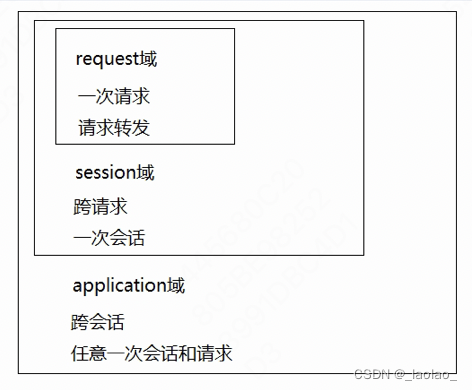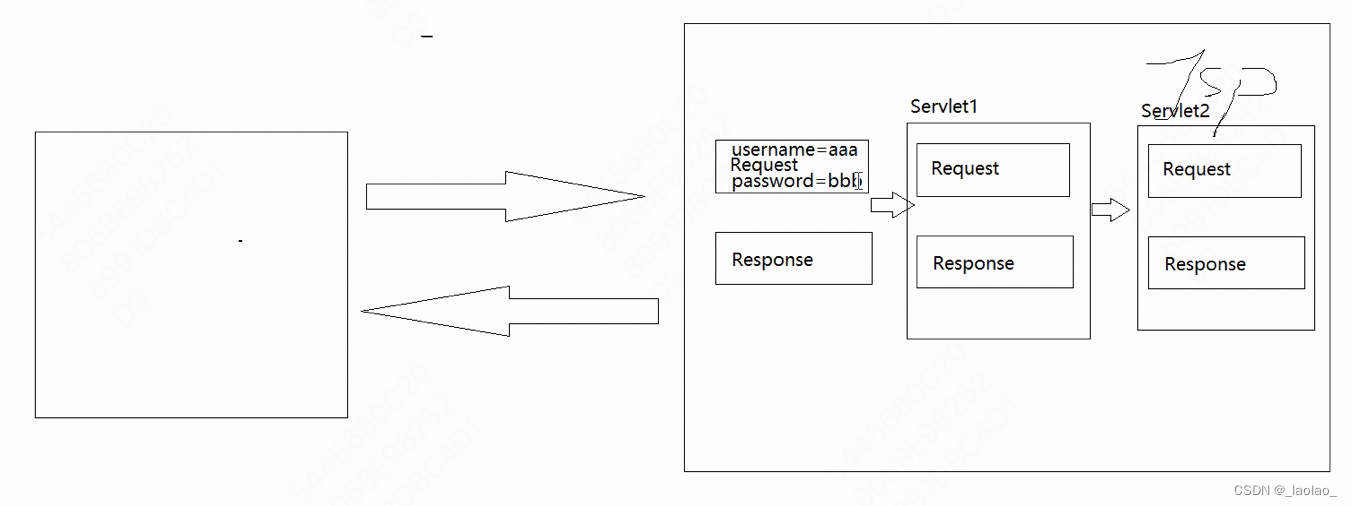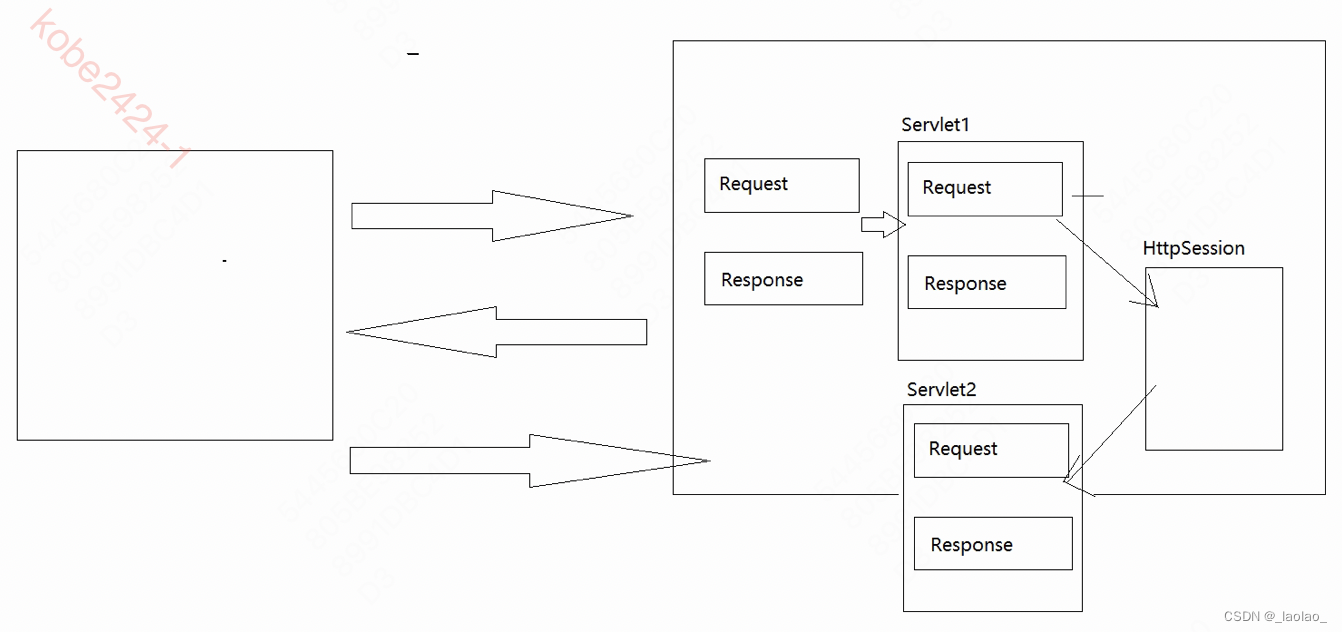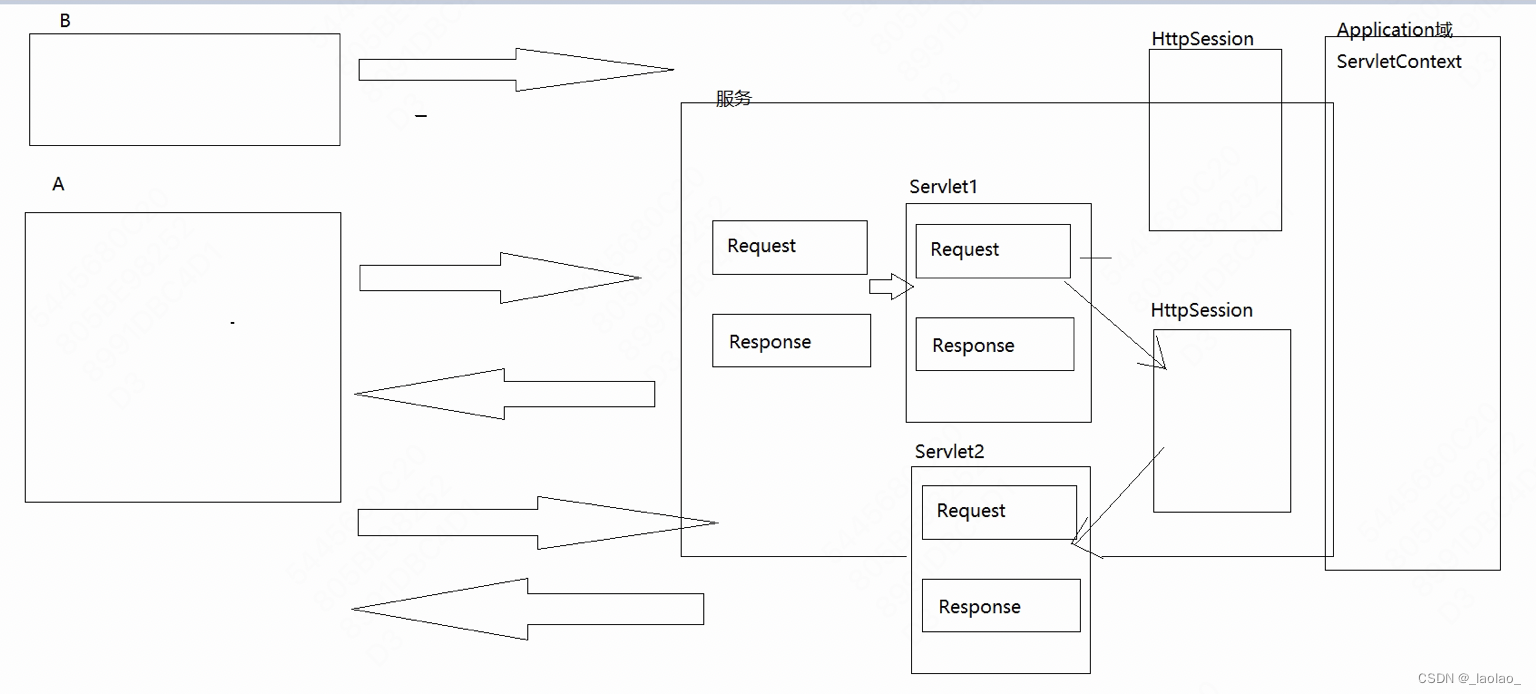5.Servlet
1.域对象概念引入
什么是域对象? 能存储数据、获取数据 并能通过共享以传递数据的对象
能够存储数据、获取数据、传递数据的对象
Servlet三大域对象:
1.Request域:对应HttpServletRequest对象,作用范围是一次请求/请求转发,生命周期是一次请求
2.Session域:对应HttpSession对象,作用范围跨请求,生命周期是一次会话
3.Application域:对应ServeltContext对象,在整个web项目下都是它的作用范围(跨会话),生命周期同这个webapp
不同对象的生命周期,作用范围都不同。
这三个域对象都有的方法:1.setAttribute(name,value) 设置/修改数据的方法 2.getAttribute(name) 获得数据的方法 3.removeAttribute(name) 删除数据的方法。我们主要使用这三个方法来通过域对象实现数据的传递。

JSP四大域对象:
1.Page域
2.Request域
3.Session域
4.Application域
2.Request域传递数据
有效范围:
一次请求内有效,请求转发时数据可以传递,除此以外该域没有办法实现数据共享。
生命周期:
创建:每发生一次请求创建一个独立的请求域
使用service方法中或者请求转发有效
销毁:一次请求结束,已经向浏览器响应数据
一次请求/一次响应,Tomcat给创建的Request对象和Response对象对所有Servlet来说都是同一个
Request域能传递数据的场景只有请求转发。

Servlet1:
package com.example.demo5;/**
* @Author:zhoayu
* @Date:2023/11/6 22:51
* @Description:com.example.demo5
* @version:1.0
*/
import javax.servlet.RequestDispatcher;
import javax.servlet.ServletException;
import javax.servlet.annotation.WebServlet;
import javax.servlet.http.HttpServlet;
import javax.servlet.http.HttpServletRequest;
import javax.servlet.http.HttpServletResponse;
import java.io.IOException;
import java.util.ArrayList;
import java.util.Collections;
/**
* @ClassName RequestDomain
* @Description //TODO
* @Author zhaoyu
* @Date 2023/11/6
*/
@WebServlet(urlPatterns = "/requestdomain.do")
public class RequestDomain extends HttpServlet {
@Override
protected void service(HttpServletRequest req, HttpServletResponse resp) throws ServletException, IOException {
//向request域中添加数据
ArrayList<String> arrayList = new ArrayList<>();
Collections.addAll(arrayList,"a","b","c");
//name:String,value:Object
req.setAttribute("list",arrayList);
req.setAttribute("gender","man");
//覆盖gender->man,修改为gender->woman
req.setAttribute("gender","woman");
//移除数据
req.setAttribute("name","xx");
req.removeAttribute("name");
//请求转发
RequestDispatcher requestDispatcher = req.getRequestDispatcher("requestdomain2.do");
//做出转发动作
requestDispatcher.forward(req,resp);
}
}
Servlet2:
package com.example.demo5.example;/**
* @Author:zhoayu
* @Date:2023/11/6 22:53
* @Description:com.example.demo5.example
* @version:1.0
*/
import javax.servlet.ServletException;
import javax.servlet.annotation.WebServlet;
import javax.servlet.http.HttpServlet;
import javax.servlet.http.HttpServletRequest;
import javax.servlet.http.HttpServletResponse;
import java.io.IOException;
import java.util.ArrayList;
import java.util.List;
/**
* @ClassName RequestDomain2
* @Description //TODO
* @Author zhaoyu
* @Date 2023/11/6
*/
@WebServlet(urlPatterns = "/requestdomain2.do")
public class RequestDomain2 extends HttpServlet {
@Override
protected void service(HttpServletRequest req, HttpServletResponse resp) throws ServletException, IOException {
//从request域中读取数据(我们之前在HttpServletRequest中设置的数据)
ArrayList<String> list = (ArrayList<String>)req.getAttribute("list");
System.out.println(list); // [a,b,c]
System.out.println((String)req.getAttribute("gender")); //woman
//获取request对象中的参数(http请求携带的)
System.out.println(req.getParameter("username")); //zy
System.out.println(req.getParameter("password")); //123
System.out.println(req.getAttribute("name")); //null
}
}
如果我们使用响应重定向呢,还能通过HttpServletRequest域对象来传递数据吗?
不行,因为重定向的话,又要向requestdomain2.do单独发起一次新的请求,不是和之前共用的一个请求。
resp.sendRedirect("requestdomain2.do")
3.Session域传递数据

Servlet1:
package com.example.demo5;/**
* @Author:zhoayu
* @Date:2023/11/6 22:51
* @Description:com.example.demo5
* @version:1.0
*/
import javax.servlet.RequestDispatcher;
import javax.servlet.ServletException;
import javax.servlet.annotation.WebServlet;
import javax.servlet.http.HttpServlet;
import javax.servlet.http.HttpServletRequest;
import javax.servlet.http.HttpServletResponse;
import javax.servlet.http.HttpSession;
import java.io.IOException;
import java.util.ArrayList;
import java.util.Collections;
/**
* @ClassName Domain
* @Description //TODO
* @Author zhaoyu
* @Date 2023/11/6
*/
@WebServlet(urlPatterns = "/session1.do")
public class Domain1 extends HttpServlet {
@Override
protected void service(HttpServletRequest req, HttpServletResponse resp) throws ServletException, IOException {
//向session域中添加数据
HttpSession session = req.getSession();
ArrayList<String> arrayList = new ArrayList<>();
Collections.addAll(arrayList,"a","b","c");
//name:String,value:Object
session.setAttribute("list",arrayList);
session.setAttribute("gender","man");
//覆盖gender->man,修改为gender->woman
session.setAttribute("gender","woman");
//移除数据
session.setAttribute("name","xx");
session.removeAttribute("name");
//响应重定向测试一下
resp.sendRedirect("session2.do");
}
}
Servlet2:
package com.example.demo5.example;/**
* @Author:zhoayu
* @Date:2023/11/6 22:53
* @Description:com.example.demo5.example
* @version:1.0
*/
import javax.servlet.ServletException;
import javax.servlet.annotation.WebServlet;
import javax.servlet.http.HttpServlet;
import javax.servlet.http.HttpServletRequest;
import javax.servlet.http.HttpServletResponse;
import javax.servlet.http.HttpSession;
import java.io.IOException;
import java.util.ArrayList;
import java.util.List;
/**
* @ClassName Domain2
* @Description //TODO
* @Author zhaoyu
* @Date 2023/11/6
*/
@WebServlet(urlPatterns = "/session2.do")
public class Domain2 extends HttpServlet {
@Override
protected void service(HttpServletRequest req, HttpServletResponse resp) throws ServletException, IOException {
//从session域中读取数据(我们之前在HttpServletRequest中设置的数据)
HttpSession session = req.getSession();
ArrayList<String> list = (ArrayList<String>)session.getAttribute("list");
System.out.println(list); // [a,b,c]
System.out.println((String)session.getAttribute("gender")); //woman
System.out.println(session.getAttribute("name")); //null
}
}
如果我们清掉了cookie(JSESSIONID就也被清掉了),再次请求的话,后端会创建一个新的HttpSession对象,上一个HttpSession对象的生命周期就结束了
4.Application域传递数据

Servlet1:
package com.example.demo5;/**
* @Author:zhoayu
* @Date:2023/11/6 22:51
* @Description:com.example.demo5
* @version:1.0
*/
import javax.servlet.RequestDispatcher;
import javax.servlet.ServletContext;
import javax.servlet.ServletException;
import javax.servlet.annotation.WebServlet;
import javax.servlet.http.HttpServlet;
import javax.servlet.http.HttpServletRequest;
import javax.servlet.http.HttpServletResponse;
import javax.servlet.http.HttpSession;
import java.io.IOException;
import java.util.ArrayList;
import java.util.Collections;
/**
* @ClassName Domain
* @Description //TODO
* @Author zhaoyu
* @Date 2023/11/6
*/
@WebServlet(urlPatterns = "/application1.do")
public class Domain1 extends HttpServlet {
@Override
protected void service(HttpServletRequest req, HttpServletResponse resp) throws ServletException, IOException {
//向application域中添加数据
ServletContext servletContext = this.getServletContext();
ArrayList<String> arrayList = new ArrayList<>();
Collections.addAll(arrayList,"a","b","c");
//name:String,value:Object
servletContext.setAttribute("list",arrayList);
servletContext.setAttribute("gender","man");
//覆盖gender->man,修改为gender->woman
servletContext.setAttribute("gender","woman");
//移除数据
servletContext.setAttribute("name","xx");
servletContext.removeAttribute("name");
}
}
Servlet2:
package com.example.demo5.example;/**
* @Author:zhoayu
* @Date:2023/11/6 22:53
* @Description:com.example.demo5.example
* @version:1.0
*/
import javax.servlet.ServletContext;
import javax.servlet.ServletException;
import javax.servlet.annotation.WebServlet;
import javax.servlet.http.HttpServlet;
import javax.servlet.http.HttpServletRequest;
import javax.servlet.http.HttpServletResponse;
import javax.servlet.http.HttpSession;
import java.io.IOException;
import java.util.ArrayList;
import java.util.List;
/**
* @ClassName Domain2
* @Description //TODO
* @Author zhaoyu
* @Date 2023/11/6
*/
@WebServlet(urlPatterns = "/application2.do")
public class Domain2 extends HttpServlet {
@Override
protected void service(HttpServletRequest req, HttpServletResponse resp) throws ServletException, IOException {
ServletContext servletContext = this.getServletContext();
//从application域中读取数据(我们之前在HttpServletRequest中设置的数据)
ArrayList<String> list = (ArrayList<String>)servletContext.getAttribute("list");
System.out.println(list); // [a,b,c]
System.out.println((String)servletContext.getAttribute("gender")); //woman
System.out.println(servletContext.getAttribute("name")); //null
}
}
换用户/清cookie,换servlet的路径访问,都不影响我们从ServletContext对象中拿到数据,因为ServletContext的对象是跨会话的,生命周期是webapp的起停。
在实际的工作中,一般不会往application域中放数据,因为它的生命周期太长了(项目停止数据才消失),因此很容易放很多数据,不要放用户信息这种,放点配置信息就得了。





















 2384
2384











 被折叠的 条评论
为什么被折叠?
被折叠的 条评论
为什么被折叠?








